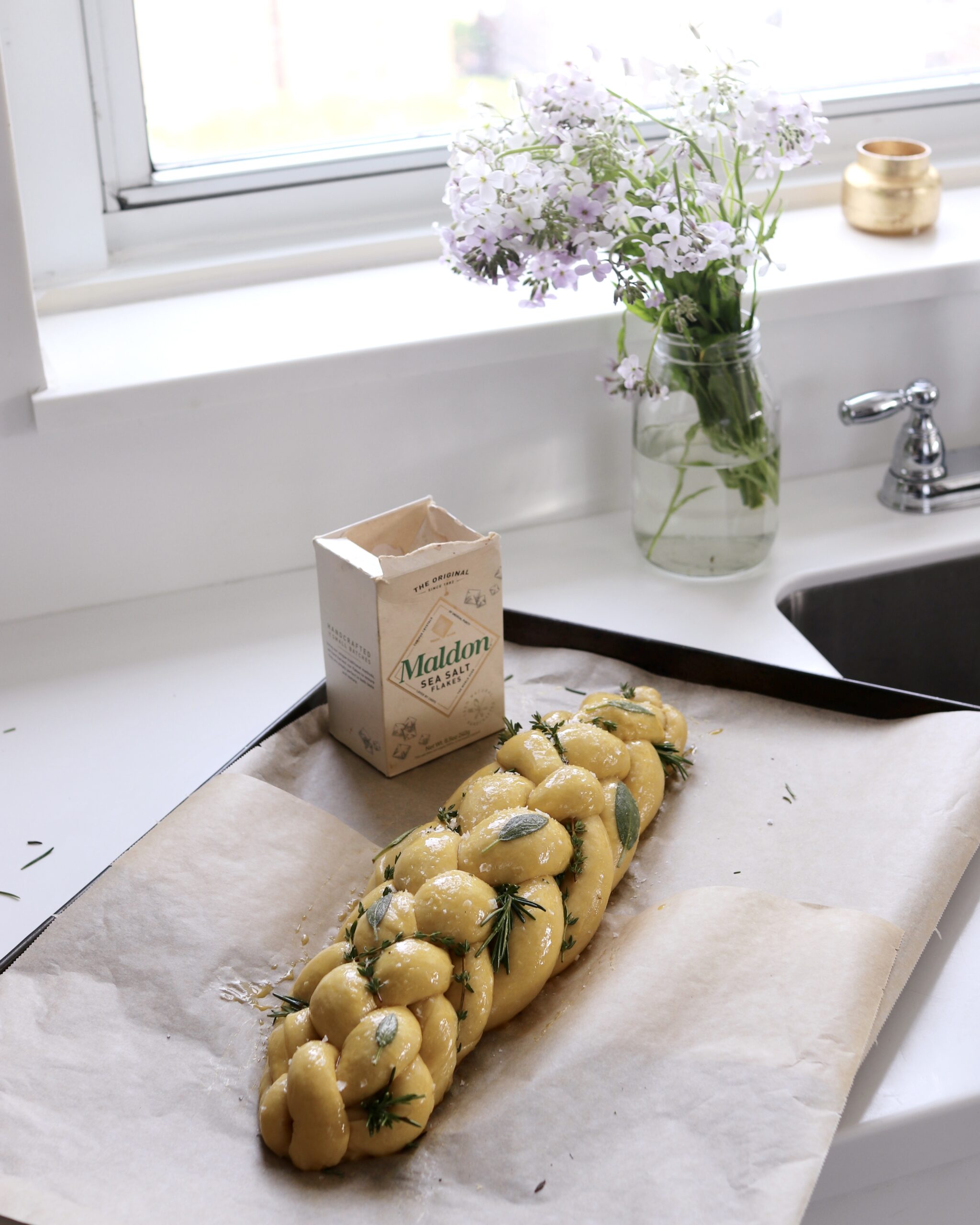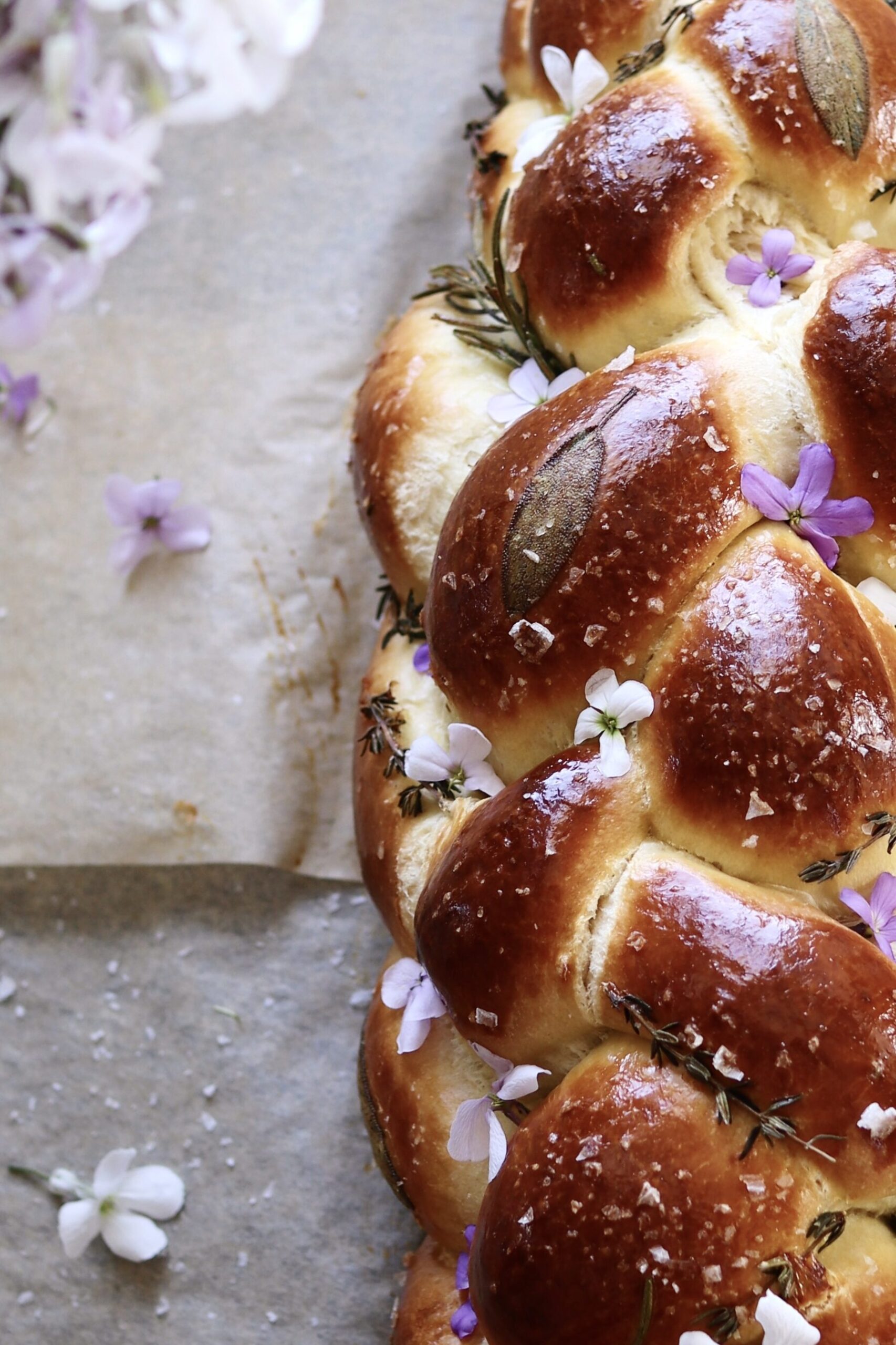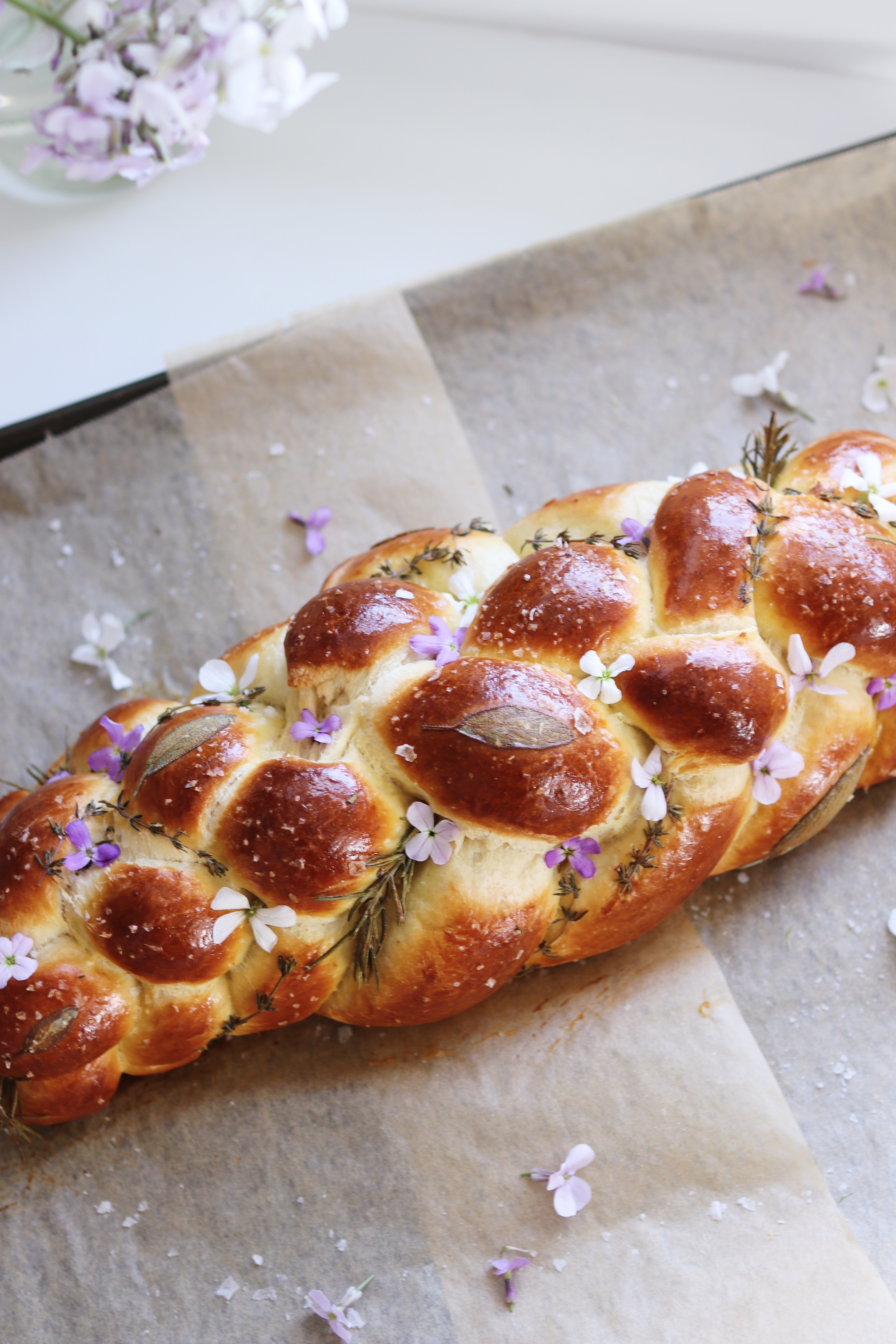Without further ado (after years of ado), here it is: my mostly traditional, mostly fail-proof, classic challah recipe. This miiight just be my most asked-about tutorial—and seeing as I post a challah video every few weeks over on the ‘gram, I can’t blame you for wondering how the heck it all comes together. So, voilà! This is my best challah recipe for perfectly soft and pillowy loaves—it’s not dry in the slightest, it’s just sweet enough, and it browns beautifully, too. I’ve also included a ton of little tips within the tutorial to help you get the dough to fully cooperate so you can avoid the typical challah pitfalls—messy dough, un-rollable strands, and so on.
More generally speaking, challah is also just a beautiful testament to thousands of years of history and hardship, celebration and ceremony, tradition and continuity. I hope you feel all of the above (well, not so much the hardship) as you prepare the bread at home.
(On that note, if you’re hoping to learn more about the history of challah, I love Julia Moskin’s insights and storytelling in this article.)
(Also, those little herbs and flowers aren’t included in the tutorial—but they’re easy enough to add! Just poke/layer on some fresh herbs after the egg wash step, prior to baking, and/or garnish with edible flowers just before serving.)


Personally, I like to mix up the dough by hand—there’s something about getting your hands into things that brings a little more thoughtfulness and spirituality to the entire baking experience. There are also so many wonderful, spiritual moments associated with the process of making challah, from the blessings that accompany it to its ritual “separation,” which necessitates some dough-in-hand action. That said, I’ve gotten a lot of requests for a stand mixer-friendly version of the recipe, and I’ve modified my recipe over the years to work well in a mixer, too; if you’re looking for that tutorial, jump over here. Either way, note that challah is a very simple bread that requires virtually no clean-up aside from the mixer bowl, a few measuring utensils, and a quick wipe-down of the counter…and I personally find the by-hand route to be the easier and less convoluted method of the two!

Of course, while challah’s easy to make, it is time-intensive—though most of that time is spent waiting around for the dough to rise—so I’d recommend reading through the entire recipe so that you can plan your morning or afternoon accordingly. You’ll also want to prep your ingredients ahead of time so that everything’s at room temperature, and to ensure that you have said ingredients. Since time is a crucial component of bread-baking, you don’t want to be running out at the last minute to grab this or that ingredient. Finally, there are so many wonderful little tips and tricks I’ve learned over the years that make a huge difference in the look and taste of the resulting loaves. For that reason, I’ve done my best to make the below tutorial really comprehensive and thorough (and, okay, a little wordy). Again, you can make sure you’ve got a grasp on all of these little details simply by giving the recipe a thorough read before you begin.
Never baked challah before? Please know that my first loaf looked a little like something out of a Tim Burton film. It’s all about repetition—the more you bake challah (or any bread, for that matter), the more opportunities you’ll have to fine-tune the little techniques that make it look and taste better. I still notice differences in my loaves from week to week. You’ll get it in time!


Classic Challah Recipe
- Prep Time: 35 minutes
- Total Time: 3 hours 35 minutes
- Yield: 1 large loaf or 2 medium-sized loaves 1x
- Category: Bread
- Cuisine: Jewish
Description
A mostly traditional, mostly fail-proof, classic challah recipe. It’s perfectly soft and pillowy, not dry in the slightest, just sweet enough, and it browns beautifully, too. Yields one large loaf or two medium-sized loaves. Find a stand mixer-friendly version of this recipe over here. (Note: Please use caution when toggling the “2x,” “3x” options below; ingredient amounts will not convert properly.)
Ingredients
For the dough:
- 2 1/4 teaspoons active dry yeast (if you’re using packets, depending on the brand, this usually translates to a little more than one; still, you’ll want to measure it out carefully to be sure)
- 1 tablespoon granulated sugar
- 1 cup warm water (if you want to be precise, between 95° and 110° Fahrenheit is ideal)
- 2 1/2 cups all-purpose flour, divided, plus another 1/2 cup for your work surface
- 2 cups bread flour
- 2 large eggs, room temperature (you can warm them up quickly by letting them sit in a glass of warm water)
- 1/2 cup neutral oil (options include avocado oil, canola/vegetable oil, sunflower seed oil, and grapeseed oil; olive oil works fine as a substitute)
- 1/4 cup honey
- 1 tablespoon kosher salt
For the egg wash:
- 1 large egg
- 1 tablespoon water
Instructions
- Dissolve the yeast with sugar, water, and flour: In a large bowl, thoroughly mix together the yeast, sugar, warm water, and 1 cup of the all-purpose flour until all ingredients are incorporated and no lumps remain. Scrape down the sides if needed with a rubber spatula, then cover the bowl with a dish towel or piece of plastic wrap and let sit at room temperature for 1 hour. (Note that you should see some bubbling/foaming and observe a subtle beer-like smell within just a minute or two—that’s how you’ll know your yeast is, in fact, active and not expired.)
- Add the rest of the wet ingredients: When the hour is up, crack the eggs directly on top of the now-foamy mixture, then pour in the honey and oil. Rigorously stir the mixture together until thoroughly incorporated and perfectly uniform in color and texture.
- Add dry ingredients and begin the kneading process: Add the salt, the remaining 1 1/2 cups all-purpose flour (continue to retain the 1/2 cup for your eventual work surface), and all of the bread flour. Use a wooden spoon to mix the ingredients together until you’re looking at a (very!) disheveled-looking dough ball. It’ll be pretty messy at this point; not to worry; you’re on the right track. At this point, throw on a pair of latex gloves (optional, but I prefer to use them for a few minutes while things are extra messy), then get your hands into the bowl and keep up the initial kneading. After another minute, you’ll be looking at an ever-so-slightly more cohesive dough ball.
- Finish the kneading process outside of the bowl: Sprinkle your work surface with a few tablespoons of the retained all-purpose flour. Remove the sticky mass of dough from the mixer bowl and place it on the well-floured surface; continue knead by hand for another 3 to 4 minutes until the dough ball is round, smooth, and supple. You might not need all of the retained flour (I typically use a little more than 1/4 cup), but continue adding until you’re satisfied with the dough’s appearance and texture: It should be smooth, supple, and tacky to the touch, but not sticky (in other words, don’t over-flour the dough if you can help it; some tackiness is expected and desired). Depending on the climate, season, and temperature within your home, you might find you need more or less of this “extra” flour each week.
- First rise: Finish shaping the dough into a true ball, then place it in an oiled bowl (lightly greased by hand with about 1 tablespoon of any oil—this just ensures that the dough doesn’t stick to the sides of the bowl as it rises). Cover the bowl and let the dough rise at room temperature for 1 hour and 30 minutes or until it’s doubled in size.
- Divide the dough and shape into rope-like strands: Once time’s up, remove the dough from the bowl. Use a bench scraper or sharp knife to divide it into four equal parts (alternatively, divide into 8 parts and set 4 aside to create two smaller loaves). Use a rolling pin (or the palms of your hands) to shape each resulting triangle into a flat rectangle; it’ll be a little oblong, but that’s okay. Then, use your fingers to carefully roll up each dough portion into a short, snake-like strand. Continue rolling the strands to gently lengthen. You’re aiming for a final length of ~10-12 inches (see next step if you aren’t able to get all the way there).
- Let the strands “rest” before lengthening them one more time: Optional, but I like to cover the strands with a kitchen towel and let them rest for a few minutes before returning for one last rolling spree; I find I can get an additional inch or two out of them when I work this way.
- Braid the loaf: There are so many ways to achieve a 4-strand braid, but here’s how I like to go about it: Pinch together the four strands at their tops to create the beginning of your weave. Then, mentally number each strand, with the leftmost strand acting as “1” and the rightmost acting as “4.” Note that these numbers are fluid; i.e. whatever strand of dough finds itself in “Spot 1” is now “Strand 1,” even if it was previously stationed in, say, spot 4. To begin braiding, first, bring Strand 4 over Strand 2. Then, take Strand 1 and bring it over your new Strand 3. Finally, bring Strand 2 over Strand 3. Continue braiding with this three-part pattern: 4 over 2, 1 over 3, 2 over 3. You’ll end up with a few stubby pieces hanging out; simply tuck these beneath the loaf.
- Second rise: Transfer the braided loaf to a parchment-lined baking sheet and cover loosely with a dish towel; let rise at room temperature for about 30 minutes. (If you’re making two loaves, now’s the time to repeat the braiding process.) Preheat the oven to 350° Fahrenheit. Prep your egg wash by whisking together the egg and water in a small bowl.
- Egg wash and bake: When the second rise is up and your oven is preheated, use a pastry brush to coat the exterior of the loaf with egg wash, making sure to get in all the nooks and crannies. Bake for 30 to 35 minutes or until dark brown. You might have to add a few minutes depending on your oven, so keep a close eye on the bread and determine for yourself when you’ve reached the right hue. If the bread is browning much too quickly and turning an extra-dark hue (unlikely but it can happen), remove it from the oven, tent the overly browned areas or the entire thing with aluminum foil, and quickly return it to the oven to finish the internal baking process.
- Let rest and serve: It’s tempting to dive right in, but it’s best to allow the loaf/loaves to rest for at least 30 minutes before serving as they’re technically still cooking on the inside (they’ll be too hot to eat right away anyway). Then, slice or tear, serve warm, and enjoy!
Notes
- Making the dough ahead of time: It’s possible to make your challah dough ahead of time—find information on doing that over here. I strongly recommend waiting to officially bake the challah until the actual day you plan to serve it, though. Day-old challah is still delicious (particularly if you wrap it tightly to seal from air), but it’s ideal on the day it’s baked; save the leftovers for things like French toast, croutons, and the like.
- Substituting bread flour for all-purpose flour (and vice versa): If you don’t have one or the other of these ingredients, you can, in fact, swap them out for each other as needed, using only all-purpose or only bread flour to make your dough. That said, don’t expect an “ideal” loaf without bread flour—and consider just running out to the store if you can (you’ve got plenty of time to do so with all that rising time!). While both substitutions are possible, the preferable swap is the use of bread flour in place of all-purpose flour.
- Substituting active dry yeast for instant yeast: For the purposes of this exact method/recipe, I don’t recommend it. If that’s all you have on hand, do a quick search for an instant yeast challah recipe instead!
- Letting the dough rise too long: Generally speaking, if you let the dough rise for a little too long here or there (5, 10, 25 minutes), you’ll be fine—don’t sweat it. What’s more, the times shared in this and other challah recipes are actually just estimated averages; depending on the altitude and temperature of your home, more or less time will be required anyway for an “ideal” bake.
- Toppings: If you’d like to top your loaves with sesame seeds, fresh herbs, and the like, do so just before baking, after the egg wash (the wash will help any toppings adhere).
- Serving idea: If serving several hours after baking, pop the loaves back into the oven for a quick reheat; just make sure you keep the temperature low, only throw them in for up to ten minutes, and (please) don’t forget about them!

I’m a retired food journalist and chef. I began tackling bread after selling my catering business six years ago.. I always had a pastry chef, so I never tackled breads. Challah is my favorite and I found your recipe today; I was looking for a nice Jewish girl for insights. Couple of questions. I am a traditionalist and believe Jews would have used olive oil (and honey). Also, how do you feel about overnight second rise, mainly for baking schedule? I’ve noticed most enriched doughs are done in no more than four-hour window. Thanks for your wisdom.
Doug Mead
Everything is great except it’s too much salt. 1 tsp would be enough.
★★★★★
I made this exactly as written. I made a single, large round 12-strand braided loaf. The Challah is delicious. The inside is pillowy. The outside has a lovely texture. It made a beautiful loaf. Because it was large I used an instant-read thermometer to make sure the center was done. I had to bake it an extra 10 minutes, tented with aluminum foil so the top didn’t get too brown. This recipe is a keeper.
★★★★★
hooray! thank you so much.
Thank you for this tutorial. I really want to try this, because I’m old, and Jewish, and think I should. However,
I disagree with your final step, cutting. Challahs are made to be grabbed and pulled apart.
★★★★★
An excellent recipe. The dough yielded makes a very satisfying single loaf, and we’ve used the base recipe (with adjusted bake times) for braided rolls and long braids as well.
The recipe itself is very easy to execute, and the time waiting for rises only adds to the excitement.
★★★★★
I was storytelling my kids it was about challah so then. They asked me to make it for them now i will try this recipe it sounds good and foolproof ❤️
★★★★★
a litte confused. I am trying to dbl [2x] the recipe. This calls for 5 cup of reg AP flour. But in the instructions you say put 1 cup initially in with the yeast and then, in a step further down, you say add teh remining 1 1/2 cups of AP flour and all the bread flour. Shouldn’t it be “the remaining 3 1/2 of AP flour….”
Hi! Ah yes, this can definitely be confusing. I actually flagged this in the notes above the recipe, because the “2x” button only updates the ingredient list, not within the step-by-step instructions. So, if you’re doubling, you’ll need to manually double the amounts in the instructions too (like the initial flour amounts). 🙂
sorry. I meant 4 cups {i cup + 4 cups to make 5 cups AP FLOUR..[NOT counting what you will need to sprinkle on the working surface……
This challah is perfect! I have been looking for a smaller challah recipe and this hit the mark. Its soft, airy, slightly sweet, and delicious !I made some cinnamon sugar and placed it inside my strands of dough and it’s a perfect fall challah.
★★★★★
I made this exactly as written. I normally use fresh yeast but bought some dried yeast (newly bought). It bubblex up wlin the initial stage when mixed with the flour and sugar. Kneaded it but it simply didn’t rise. Can I use fresh yeast for this recipe?
Hi! I’m sorry to hear that and can’t be totally sure what happened there – sometimes bread dough just has an off day, and it can be hard to pinpoint exactly why. I’ve made this for years with active dry and so have so many others, so I’d definitely say to give it another try – I really hope it works out this time!
Rebekah–I followed the recipe almost exactly (didn’t do the 2nd rise/rest of the “ropes”). I kept a small portion out (tithe-like) but then taste tested because these will be gifts. WOW–best, moistest Challah I’ve ever made!! Thank you for this recipe!!
★★★★★
I made my first ever Challah using your recipe in fact this was my first attempt to make bread period and it came out beautifully. It was easy to follow along and all the tips and tricks helped me when I struggled. I only wish I could attach a photo as I am so proud of how lovely my loaves look!
★★★★★
I have instant yeast and not active dry yeast. How much instant yeast do I use?
Hi! This recipe is really designed around active dry yeast, especially with that first proofing step. While instant yeast and active dry yeast are generally interchangeable, I’d recommend following a recipe written for instant yeast from the start to get the best results. Hope this helps!
Came out amazing, so many compliments!
★★★★★
Hi Rebekah!! My bread turned out really dense after I followed the instructions. Should I add less flour and maybe stir it in? I am totally lostttt but I am also bad with bread dough texture.
Shabbat Shalom to you!! Thank you for this recipe!
Hi and thank you so much for the comment! Hm, I can’t pinpoint for sure what the problem is, but a couple of thoughts: It *could* be the flour; flour absorption varies with humidity, climate, brand of flour, etc. so it really helps to go by feel as well as measurements – I always look for a dough that feels soft and just slightly tacky but not sticky. Or it could potentially be an issue with kneading (you want to really build that elasticity). Or it could be proofing time (you want to give it plenty of time to rise until it’s nice and puffy). Sometimes things take longer/shorter depending on your kitchen temperature. You’re not alone in this – bread dough is such a learning curve, and challah especially takes a little practice to get a feel for the texture. Every batch teaches you something new. Lemme know how it goes if you do make it again! 🙂